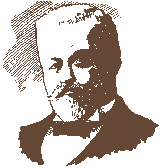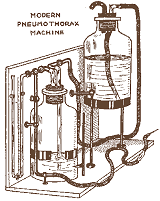
|
Artificial Pneumothorax -- "Pneumo" |

|
|
A sanatorium patient receives pneumothorax treatment from Dr. GH Hames in Saskatchewan during the 1940s. |
Another way to collapse or deflate the lung is by a simple operation called pneumothorax. Lying quietly in the chest like a balloon, the lung has a chance to heal. Later, it may be allowed to inflate again and breathe as before. Sometimes only a part of the lung is collapsed. Collapse of the diseased lung also closes any holes in the lung that may have been caused by the disease. (In such cavities, there are thousands of tuberculosis germsand these may be coughed up spread to other people.) Pneumothorax was, therefore, not only a blessing for the sick person but also a protection for the well.
|
|
|

|
|
Carlo Forlanini, an Italian physician, injected air into the chest of a tuberculous patient in 1882. He is given credit for the discovery of artificial pneumothorax as a practical procedure. |
Perhaps the oldest known surgical treatment for lung disease, pneumothorax was described by Hippocrates over 2400 years ago. This practice was suggested for use in treatment of Tuberculosis early on, but the first report of a successful case came from Forlanini of Italy in 1888. Until this time, pneumothorax was a crude procedure of cutting a hole through the chest wall and injecting air pressure. Pneumothorax was attempted for hundreds of years before Lister introduced the use of antiseptics, and patients invariably suffered secondary infections that just complicated their Tuberculosis.

|
|
(ca. 1936) |
In Canada, the first artificial pneumothorax treatment was given in 1898 by a family physician, Dr. J.M. Rogers, at Ingersoll, Ontario. The combination of a water "manometer" to measure the amount of air pressure given--invented in 1911, and the common use of x-rays by this time lead to further perfection of the pneumothorax therapy worldwide, and pneumothorax soon became the most common surgical treatment for tuberculosis. Patients in Canada could look forward to visiting "Pneumo" once or twice per week for a 3-4 year period during their stay at the sanatorium. The type of pneumothorax machine used in Canada during the 1930s (pictured at left) was fitted with two bottles and several valves which together made a manometer--allowing the surgeon to accurately gauge the amount of air being pumped into the space surrounding the patient's lungs.
|




